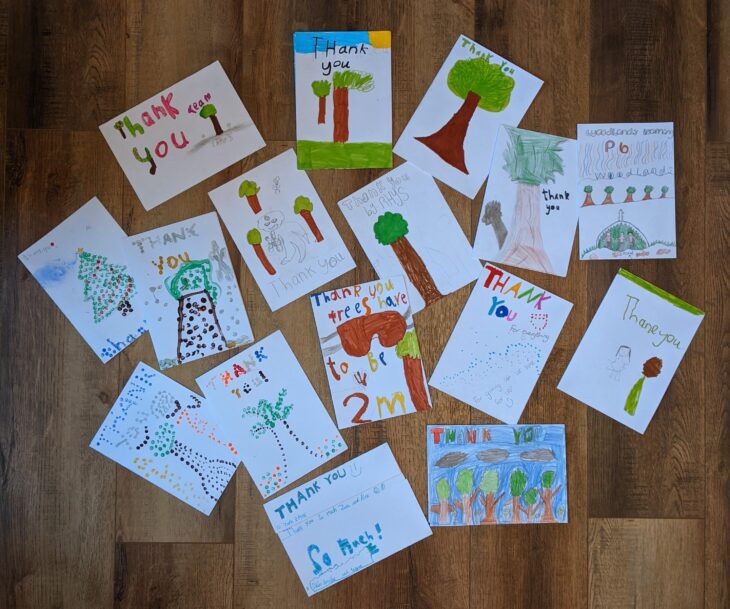Wild About Woodlands
,

Our final Early Connections session of the 2021 needed to be something suitably celebratory. We wanted our last session of the year to be one to remember – so I, along with Cumbernauld Living Landscape trainees Alex Paterson and Rozelle McMillan, arranged with John Green, Principal Teacher at Woodlands Primary, to do a suitably festive Wild About Woodlands themed sessions for the P4 and P6 pupils.
Early Connections sessions have been designed to connect children with the nature on their doorstep – and this has been carried through all four years of the project. We hope this will encourage local children to spend more time out of doors and get to know their local greenspaces – through understanding what is there and what they can do to protect the wildlife they find.
Sessions always open with a meditative activity – which in this final session of the year was an opportunity for the children to make like yews! The children were invited to don blindfolds and feel their feet root into the earth, and maybe even feel their branched hyphae roots (which I often refer to as fungi filaments’) – which make up the mycorrhizal networks that work to help trees to talk to one another.
We also spoke about how the festive log (known as the yule log) – most often covered in chocolate nowadays – would have originally been sourced from yew. As a slow burner, this yew log would have been put in the hearth to burn for 12 days over the midwinter season, spanning this time of change of which yew trees became a symbol.
Our final ‘Wild About Woodlands’ session opened with a poetry starter – which the teacher of the P4 class kindly volunteered to read in her best Scots dialect! The poem about the rugged rowan (called ‘The Rowan Tree’) was a traditional song-like poem written between 1766-1845 by Carolina Nairne. While the poem was being read, the children got to handle a rowan sapling which was passed around the circle – a chance to observe bud formation and lenticles and as one pupil pointed out the “many hairy roots!”
The poem’s vivid description of the berries led us nicely into an informal and lively Q&A way of investigating how the features of the tree support native wildlife species. We honed in on how certain species of birds are particularly reliant on the ‘masting’ of trees like rowan – especially those which that flock like fieldfare, redwings, long-tailed tits – or even waxwings. It was great to have the input of Alex Paterson on this point – she spoke to the children about the difference between fieldfares and redwings – as well as the bird behaviour of flocking.
Following this, we quickly moved on to some movement play – it was time to warm up with a parachute game. These giant colourful play props always bring out the smiles and immediately inject colour and fun into a session. This being quite a ‘dreich’ day, the parachute was an especially welcome prop and the game of’ ID the Cone’ made for lots of laughter amongst the 8 and 9 year olds. The aim was to be the first to name the cone correctly before it fell off the parachute – as well as to say whether it was native or non-native. The cones we used were Norway spruce, larch, Sitka spruce and Scots pine.
After all the fun of this activity, it was time to split the group in two – so that we could get cracking with some tree planting. Our wonderful trainees volunteered to lead the tree planting. This linked beautifully to an earlier point that was made about the benefits of clearing coniferous plantations – to make way for native broadleaf trees and their greater biodiversity. Raising awareness about the need to manage non-native species and how this allows us to protect and restore the diversity in woodlands is a key part of the CLL project’s aims. The second group interchanged with the tree planting group after being part of our ‘Tree Identification Zone’ – a chance for the second group to have a go at matching the branches from 18 trees in a kind of ‘Twig snap’- once the children felt confident using the ID sheets (also laid out to support them) they could peg the branch to the ID card. The takeaway from this was not only to be able to identify the three native conifers (yew, Scots pine and juniper), but also to make sure that the understood the difference between ‘coniferous’ and ‘evergreen’ – and ‘broadleafed’ and ‘deciduous’ trees.
The session culminated in planting over 60 trees and then the children presenting us with a big box of chocolates and cards from every pupil – which was such a wonderful as well as unexpected surprise for Alex, Rozelle and me.

Speaking to the trainees after the session, I was keen to learn how they felt it had gone – as they had been such a key part of the delivery. Alex Paterson said she felt: “the children at Woodlands Primary were so engaged with our session. They seemed to really enjoy learning about trees and how important they are to us all! It was a great experience for everyone involved”. Rozelle McMillan chipped in with: “The interactive learning is a good chance for the children to get involved and see first-hand what the tree species are. The practical element helped children memorise tree types as it was an enjoyable experience.”
